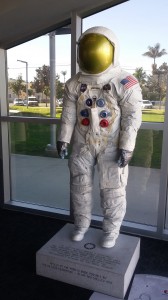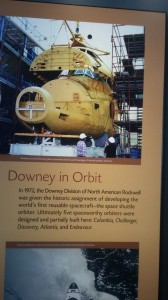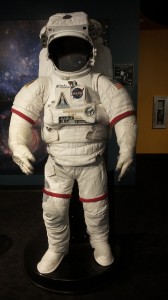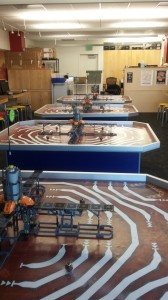THE COLUMBIA MEMORIAL SPACE CENTER
THE COLUMBIA MEMORIAL SPACE CENTER
By Charles N. Stevens
Photos by Dolores Seidman
Only a few blocks from “downtown” Downey is the Columbia Memorial Space Center. It stands on the ground formerly occupied by the sprawling Boeing/ Rockwell/ North American plant vital to America’s space program. The modern metal-skinned center was built in 2008 in part to memorialize the area’s participation in the exploration of space and as a working museum supplying the public with information about the space program.
As you enter the center you are met by a manikin wearing a 300-pound space suit and the sharp crack of bottle-sized “rockets” being launched but safely contained. All through the first and second levels are attractive displays and interactive exhibits. In a glass case is a portion of Apollo’s heat shield showing the protective layers necessary to protect the capsule and those astronauts inside from burning up as it reenters the earth’s atmosphere. Nearby is a draftsman’s desk with a schematic print of a space capsule spread out upon it. Another display is in the form a smooth funnel-like device in which marbles inserted at the top spin gradually down, faster and faster, to illustrate facts about gravity and circular orbits.
On a previous trip to the center with my great grandchildren, they gravitated toward the interactive displays, particularly a device that would launch a paper airplane that they had made into a short trajectory. They loved flying a model airplane in an enclosed wind tunnel.
On the second level is an astronaut’s suit with an empty space under the helmet where a person can place his face. This is especially attractive to kids.
We were shown two films, one about Apollo 11 that took man to the moon and back and the other about the exploration of Saturn and its moons by the Cassini Program.
A large room off the first level is reserved for the study of robotics. We watched people, simulating that they were on Mars, use computers to program toy-like vehicles that would travel a short distance to pick up a stone and take it back to its starting point. I can imagine the level of excitement when a school group operates a number of these vehicles. This is a great introduction to the science of robotics.
The city of Downey has been a center of aircraft production and later involved in the space program since 1940 when the Vultee plant began producing the Vultee Valiant basic training plane for future pilots. If you lived in the area during World War II, you might have seen them flying their test runs.
When airplane production ceased, the company began to manufacture missiles of all sorts. Later, after President Kennedy declared that the United States would put a man on the moon, the plant buzzed with the Apollo Program, making command modules and later the space shuttles. In 1964 the company employed 35,000 workers.
When the space program ended, the entire plant was dismantled, leaving nothing but bare land again. Part of this open space was used for new businesses, stores and restaurants. The Columbia Memorial Space Center now stands on that cleared land. The center memorializes the space shuttle Columbia, the first shuttle made, and its tragic demise in 2003 when it disintegrated upon reentering the earth’s atmosphere.
The Space Center is operated by the city of Downey and is located at 12400 Columbia Way. It is open every day except Sunday from 10 a.m. to 5p.m. Adult tickets are $5, seniors $3. There is a nice picnic areas next to the center.
The center operates camp, workshops and events about space, hoping to interest youth in the STEM program. It is a great place to visit for the whole family.

A man wearing a 300 pound space suit meets us at the entrance.

Reusable space shuttles were produced in Downey at the North American Rockwell plant.

Kids like putting their faces into the opening of the space suit.

This entire room is devoted to the teaching of robotics.
MONTEREY PARK AUTHOR PUBLISHES 4th BOOK – Seeking More of the Sky: Growing Up in the 1930’s:
Charles “Norm” Stevens, a 43 year resident of Monterey Park has recently published his 4th book: Seeking More of the Sky: Growing Up in the 1930’s. This is the story of a young boy growing up in Inglewood, California in the l930’s. This was a time during the depression when unemployment was affecting many and the banks were closed, while the clouds of war were gathering in Europe. But he was lucky enough to be raised in a loving family, the power of that love reflected throughout his stories.
Stevens is the author of three previous books about his experiences during WWII:
An Innocent at Polebrook: A Memoir of an 8th Air Force Bombardier (Story of his 34 bombing missions from his base at Polebrook, England over Germany and France)
The Innocent Cadet: Becoming A World War II Bombardier (A prequel to the first, telling of his training in the U.S. before going overseas into combat.)
Back from Combat: A WWII Bombardier Faces His Military Future from Combat: (This book details the time from when he returned from combat in England until the end of the war.)
He is known to the readers of The Citizen’s Voice as the author of Travel Log Articles including “Cruising the Rhine and Mosel”,” Best of the West”, “In Search of Snow” , “From Paris to Normandy on the Seine”, and “Exploring New York”. He is retired, having taught for 32 years, primarily in the Montebello Unified School District.
Those interested in purchasing an autographed copy of any of his books, may contact the author at 323-721-8230 or Normstevens24@gmail.com.



